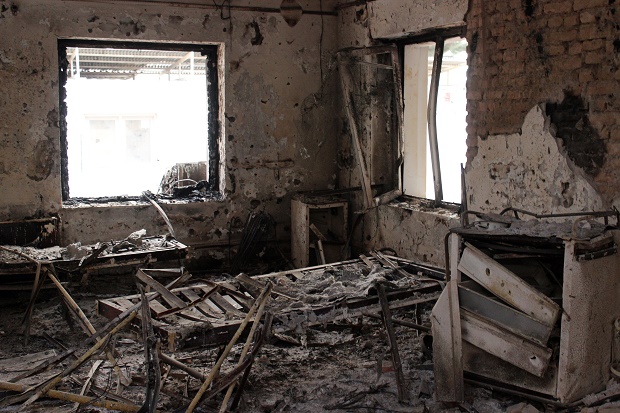
In this Oct. 16, 2015 file photo, the charred remains of the Doctors Without Borders hospital is seen after it was hit by a U.S. airstrike in Kunduz, Afghanistan. Inside the intensive care unit of the Doctors Without Borders hospital in Northern Afghanistan in the early hours of Oct. 3, 2015, the situation was as normal as it could be in the middle of an active war zone, the charity says in a report. Then an American AC-130 arrived and began firing its fearsome weapons. The Intensive Care Unit was hit first. AP FILE PHOTO
WASHINGTON — Inside the intensive care unit of the Doctors Without Borders hospital in Northern Afghanistan in the early hours of Oct. 3, the situation was as normal as it could be in the middle of an active war zone, the charity says.
Doctors were performing surgery. Nurses milled about attending to bed-bound patients, including two children. The surrounding compound was calm and quiet, according to witnesses.
Then an American AC-130 arrived and began firing its fearsome weapons. The Intensive Care Unit was hit first.
Several doctors and nurses were killed immediately, and patients who couldn’t move burned to death in the ensuing fire, according to a detailed new account of the attack by the international aid group based on interviews with 60 staff members.
READ: Doctors Without Borders marks 1 month since hospital attack
The 13-page report disclosed no major revelations but painted a clearer picture of what the group says was happening in the hospital in the days before the US strike that American officials are calling a mistake. Doctors Without Borders says at least 30 people were killed.
During an aerial attack that lasted an hour, staff members made 18 attempts to call or text US and Afghan authorities, the group says. Witnesses recalled hearing the whine of propellers and experiencing a series of ground-shaking explosions.
People fleeing the main building were cut down by gunfire that appeared to track their movements, while a patient trying to escape in a wheelchair was killed by shrapnel, the report says.
The AC130, a large propeller plane, fires three types of munitions, including an electric Gatling-style machine gun that can fire as many as 6,000 rounds per minute, and a 105mm cannon that can blow huge holes in buildings.
The charity acknowledged that as many as half of the patients in the days leading up to the attack were Taliban fighters wounded in battle as US-backed Afghan forces sought to retake Kunduz, which had been seized by the Taliban. Two of the Taliban patients appeared to have been high-ranking, the report says.
But Doctors Without Borders staffers say no one was armed and no one was firing from the hospital, as an initial American account suggested. The group says it didn’t allow weapons in the hospital and didn’t have armed guards.
If that account is true, the hospital could not have been a valid target under US rules of engagement or the international law of war.
The US military has not offered its version of events as it awaits the result of US and NATO investigations. But Rep. Duncan Hunter, a Republican Iraq war veteran who serves on the House Armed Services Committee, has heard from members of the special operations unit that was in Kunduz who insist they were fired upon, his spokesman said Thursday.
Hunter is questioning whether the mistake rested in part on the military’s controversial Distributed Common Ground System, which is supposed to provide information about the battlefield but has been bedeviled by problems.
The Associated Press has reported that both senior officers and intelligence analysts from the 3rd Special Forces Group members on the ground in Kunduz were aware that the Doctors Without Borders hospital was functioning but believed it had been overrun by the Taliban. The group says it provided the US with the exact GPS coordinates of the facility.
US intelligence analysts were examining reports that the hospital was being used as a Taliban command and control center, and that a Pakistani intelligence operative was on the scene.
“Whether there was fighting on the ground or not, none of it can account for the massive intelligence failure that could have derived in part from bad information,” Hunter spokesman Joe Kasper said.
Acting Afghan Defense Minister Masoom Stanekzai, in a recent interview with the AP, also said the hospital was being used as a command center for Taliban militants who seized the city on Sept. 28. The militants held Kunduz for three days before being driven back by an Afghan counteroffensive.
The day before the air strike, a US official in Washington asked Doctors Without Borders whether the hospital or any other of the group’s facilities locations “had a large number of Taliban ‘holed up,’ and inquired about the safety of our staff,” the report says.
The group “replied that our staff were working at full capacity in Kunduz and that the hospital was full of patients including wounded Taliban combatants.”
READ: Doctors Without Borders demands better security in Yemen after hospital attack
Doctors Without Borders’s general director, Christopher Stokes, said the official’s question “seems to suggest they believed there were a group of Taliban holed up that weren’t only patients in the hospital.”
But “this was not a ‘Taliban base,'” Joanne Liu, the group’s president, said in a statement.
Doctors Without Borders, which operates under its French initials, MSF, has called for an independent international investigation into the bombing. But the U.S has not agreed.
Navy Capt. Jeff Davis, a Pentagon spokesman, said the military will review the Doctors Without Borders report as part of its investigation into the incident, and that Gen. John Campbell, the top US military commander in Afghanistan, met with representatives from Doctors Without Borders on Wednesday.